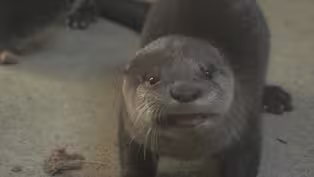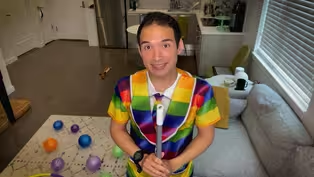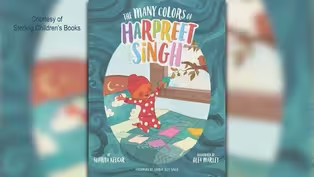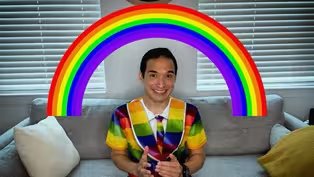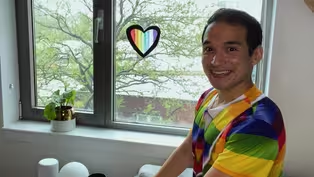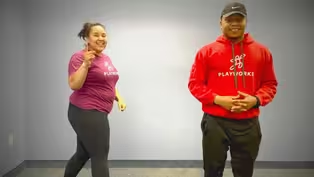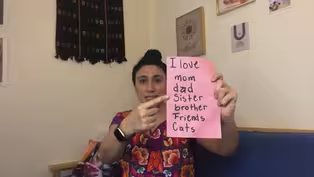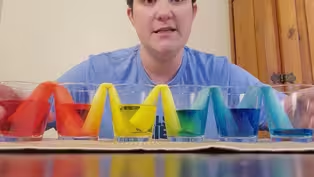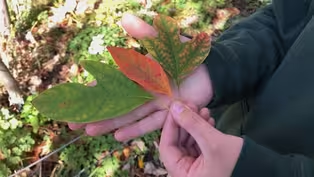
Rainbow Day (Long Version)
7/13/2021 | 56m 56sVideo has Closed Captions
Make a walking water rainbow, sing about colors, learn why the sky is blue, sketch clouds!
Join head counselor Zach to make a walking water rainbow, sing about ROYGBIV, learn why the sky’s blue, sketch clouds, meet elephants & river otters. Content partners include Brooklyn Botanic Garden, Children’s Museum of the Arts, Denver Museum of Nature and Science, Guggenheim Museum, New Victory Theater, Playworks, Roger Williams Park Zoo, San Diego Zoo, They Might Be Giants.
Problems playing video? | Closed Captioning Feedback
Problems playing video? | Closed Captioning Feedback
Camp TV is a local public television program presented by THIRTEEN PBS

Rainbow Day (Long Version)
7/13/2021 | 56m 56sVideo has Closed Captions
Join head counselor Zach to make a walking water rainbow, sing about ROYGBIV, learn why the sky’s blue, sketch clouds, meet elephants & river otters. Content partners include Brooklyn Botanic Garden, Children’s Museum of the Arts, Denver Museum of Nature and Science, Guggenheim Museum, New Victory Theater, Playworks, Roger Williams Park Zoo, San Diego Zoo, They Might Be Giants.
Problems playing video? | Closed Captioning Feedback
How to Watch Camp TV
Camp TV is available to stream on pbs.org and the free PBS App, available on iPhone, Apple TV, Android TV, Android smartphones, Amazon Fire TV, Amazon Fire Tablet, Roku, Samsung Smart TV, and Vizio.
Providing Support for PBS.org
Learn Moreabout PBS online sponsorship[upbeat music] - Hi everybody, my name is Zach and welcome to Camp TV.
Are you ready for some summer fun?
Me too.
Now, as your head counselor, I will be introducing you to all sorts of cool activities, arts, crafts, games, math and science, as well as some of my favorite books, nature and theater.
I will be here to take you from one activity to the next.
So follow me on Camp TV.
[upbeat music] - [Narrator] This program was made possible in part by the Corporation for Public Broadcasting, a private corporation funded by the American people.
Additional funding was provided by the Peter G. Peterson and Joan Ganz Cooney Fund, and the Pine Tree Foundation of New York.
[soft music] ♪ Camp TV ♪ ♪ It's time for us to start ♪ ♪ From funny animal encounters ♪ ♪ Some reading and the arts ♪ ♪ No matter what the weather we'll explore it all together ♪ ♪ The place for and me ♪ ♪ Is Camp TV ♪ - Hi, and welcome to Camp TV.
I ask you, is there anything more magical in nature than rainbows?
Oh, there's just something about them.
I love it.
When the rain clears, the sun peaks out, and there it is, seemingly out of nowhere, a big, beautiful, colorful arch in the sky.
You have to be lucky to see one, but when you do, wow, there's nothing quite like it.
Rainbows have inspired countless fairy tales, songs and works of art.
They're also a symbol of hope, celebration and pride in many cultures and communities.
For me, it is undeniable, rainbows just make me happy, kinda like hanging out with you.
So without further ado, welcome to Rainbow Day on Camp TV.
See you after your first few activities.
[upbeat music] A little birdie told me it's time to go wild.
[upbeat music] [calf trumpeting] [upbeat music] [elephant trumpeting] Curiosity and wonder, let's discover together.
It's science, wow.
- Hi, my name is Ginny Quaney and I am an educator performer at the Denver Museum of Nature and Science, we are going to be creating a water rainbow, a walking water rainbow, which sounds pretty cool.
One, two, three, four, five, six, there's all six of them.
And here I have my food coloring.
You can also use, if you have some at home, water color, mixing colors, those work just as well as food coloring.
So what I'm going to do is I'm going to put red in the first glass.
I am going to put yellow, I'm going to skip a glass, as you might be able to figure out why, and put yellow in the third glass.
I'm using a couple of drops of food coloring that's usually enough.
And then I'm gonna put blue in the fifth glass, one, two, three.
What I'm going to do with the water is I'm only gonna fill the glasses that have the food coloring in them.
So, and I'm going to fill them as close to the top as possible, this makes the experiment go a little bit quicker.
So I'm gonna fill each one pretty much to the top.
Now some people do this in a circle, and in a second you'll see why once we start mixing.
Know what, my red looks a bit orange.
I'm gonna add a little bit more to make sure that it is really red and not orange.
Okay, that's red, I promise it's red, sometimes things look a little different on video.
All right, so what we're gonna do next is we're gonna take our paper towels.
And I'm gonna take the half sheet that I have, and I have three of them, and I'm going to tear it in half.
All right, and then I'm going to take that half and fold it as many times as I can, all right.
And I'm gonna fold it like this.
And I'm gonna do that with every single one that I have, all right?
You want it to be pretty thick, this will help the experiment move pretty quickly, all right?
So what we're gonna do once we have our paper towels like this, is we're going to put one end in the empty cup, and one end in the full cup, all right, and we're gonna do this, you can see already, it's moving pretty fast.
And we're gonna do the same thing with the yellow right here, and we're gonna put empty, put it in the yellow.
You may be able to see or figure out what is going to happen here pretty quick.
All right, so as you can see, the water is going up and being soaked up by the paper towels.
And as the paper towels soak them up, it's dripping, it's leaking into the empty cup next to it.
And you can see it's happening with the yellow, and the blue as well.
Now, what's pretty cool about this is, when you have the yellow going this way, and the red going this way, what is that gonna make?
And you're starting to see the rainbow here, which is pretty fun.
So this may take a little while depending on the material that you're using for the soaking up.
You can see that my orange one, which is the one that's been going the longest, it's going pretty fast, the green one has a little bit more, and obviously the blue one has half as much water going into it because it doesn't have the other side.
But if you do these in a circle, you will be able to see the red plus the blue and make the purple.
Why is that happening?
The reason is called, is this really cool effect, it's called the capillary effect or capillary action.
capillaries are the itty bitty, teeny tiny, very thin, sometimes microscopic, blood vessels in our body.
And since blood is mostly water, this is how blood moves through those teeny, tiny capillaries.
It's also how water moves from the roots of a plant all the way up to the top.
You would think it wouldn't be able to because gravity, right?
Gravity is pulling water down.
Well, this cool effect, what happens is, the water, if you can see a little bit here, if you have a glass or root or something, what happens is that the water will start to adhere, it'll start to stick to the side or whatever fiber that is in the water.
In this case, it's those paper towels, so the water starts to stick to the paper towels.
But water also likes to stick to itself too, and so what you see is, these water droplets start to climb, and they'll climb by sticking to the sides and each other going up and up and up.
And what you will see is, you will find your rainbow occurring until all the glasses are even.
Once the glasses are even, the paper towels are completely soaked through, there's not really any place for the water to go.
Now, I'm gonna show you what happens if you wanna do this sort of in a circle style, which I think is pretty cool, and I encourage you to give it a try.
And I will put another paper towel in here so that you can see the purple go.
There's the blue, and there's the red, and as you can see, since the red is higher up, it's going much quicker.
And you'll be able to see the red go into the purple.
Let me show you what it looks like from the top.
It looks pretty cool, and you can definitely see there is rainbow happening.
Thanks for joining me.
[upbeat music] - [Announcer] Jump, dance, play.
It's time to get active, let's move.
- Hello everyone, and welcome to Playworks recess.
I'm Coach Naj.
I'm Coach Zok.
- [Both] Let's play.
Let's get started with some stretching first.
We are gonna send our hands all the way to the ceiling.
And then we're gonna paint the walls with our palms and dive down to touch either our knees or our toes, whichever one feels more comfortable with you.
Great job, let's roll it on back up.
One more time, send those hands all the way to the ceiling, and dive back down to touch either your knees or your toes, whichever one feels better.
While we're stretching out the backs of our legs and our lower back, you can play with your stretch, you can rock from side to side, or you can bend your knees and straighten them, whatever makes you feel best.
Awesome job, let's roll back up.
We're gonna clasp our fingers together now and put them over our head.
We're gonna stretch to the right side and the left side, and back to the right side, and then the left side.
Awesome jobs, drop those arms down nice and heavy.
Next, we're gonna roll our shoulders back for four counts.
Four, three, two, one.
Now let's roll them forwards.
Four, three, two, one, fantastic.
We're gonna roll our head around now to the right side.
We're scratching our neck and opening up our chest.
Great job, and reversing going the opposite direction.
Awesome job.
Now it's time to shake it out.
You are all stretched and ready to play.
We're gonna play a really awesome game today called red light, green light.
You may have heard of it before.
Let's start with the rules.
When I say red light, green light one, two, three, you all are gonna move around as much as possible.
My back is gonna be turned while you're moving around.
When you see me turn around though, everyone's gonna freeze.
I wanna see you frozen like statues, okay?
So I think it's time to try it out, you wanna go for a new round?
Awesome, let's do it.
Red light, green light, one, two, three.
Great job Coach Zok, great job team at home.
Let's try it again.
Remember, when you hear me say, red light, green light, one, two, three, you're gonna move around as much as possible.
Let's try again.
Red light, green light, one, two, three.
Great job everyone.
Look at how skilled you are.
Let's do another round.
Red light, green light, one, two, three.
Excellent job team, you all are so amazing.
I think we should take it up a notch.
This time when I turn around and you all freeze.
If you're still moving, you got to give us two jumping jacks before the next round.
How's that sound?
Want to try it out?
Let's show you how to do perfect jumping jacks.
You ready Coach Zok?
Awesome.
Good job, oh, great team.
Let's try our new round.
Red light, green light, one, two, three.
Great job, everyone is frozen.
Let's do it again.
Red light, green light, one, two, three.
Awesome job, way to stay frozen.
Let's do it again.
Red light, green light, one, two, three.
Oh, man, Coach Zok was still moving.
You got to give us those two jumping jacks.
Excellent job.
Good job team.
That was great, let's close out our awesome Playworks recess time with a clap.
Are you ready?
This clap is going to be the track star clap.
When I say one, two, three, we're all gonna clap, and then run in place as fast as we can.
Are you ready to try it?
Awesome, one, two, three.
[both clapping] [feet stamping] Great job team, we had a lot of fun playing with you, bye.
[upbeat music] - Welcome back to Rainbow Day on Camp TV.
Rainbows can be tough to spot sometimes, but when they do appear, at least they're consistent.
They're always made up of the same colors in the exact same order.
Let me show you.
The colors of a rainbow are made up of red, orange, yellow, green, blue, indigo and violet.
Always in that order.
Always with red on top, followed by orange, then yellow, then green, then blue, indigo and violet.
Wait, what?
We were just getting started.
[sighs] Anyway, if you're looking for a surefire way to remember the colors of a rainbow, look no further.
Do I have an acronym for you?
Nope, I didn't just sneeze, I said acronym.
An acronym is a made up word that helps people remember something.
It's an abbreviation that uses the first letter of a word in a phrase.
If you put the first letters together, you have your made up word, an acronym.
In this case, the acronym we're using is ROYGBIV.
ROYGBIV stands for the colors that make up a rainbow.
It's the first letter of each color.
Watch, R is for red, O for orange, Y is for yellow, G for green, B for blue, I for indigo and V for violet.
ROYGBIV.
See, and once you learn it, ROYGBIV, it's kind of like riding a bike, you never forget it.
So, keep practicing, say it often, and you too will have it stuck in your head.
ROYGBIV, ROYGBIV, ROYGBIV ROYGBIV, ROYGBIV, ROYGBIV ROYGBIV, ROYGBIV, ROYGBIV ROYGBIV, ROYGBIV, ROYGBIV [snoring] ROYGBIV [snoring] ROYGBIV ROYGBIV [sighing] Sorry, must have dozed off there for a second.
I was dreaming about rainbows.
See you after your next few activities.
ROYGBIV ROYGBIV ROYGBIV - [Announcer] Curiosity and wonder, let's discover together, it's science, wow.
[upbeat music] ♪ R is for red ♪ ♪ O is for orange ♪ ♪ Y is for yellow ♪ ♪ And G is for green ♪ ♪ B is for blue ♪ ♪ I for indigo ♪ ♪ V is for violet ♪ ♪ That spells ROYGBIV ♪ ♪ ROYGBIV is the color format ♪ ♪ And he proudly stands at the rainbow's end ♪ ♪ ROYGBIV is the color format ♪ ♪ And his spells out the whole color spectrum ♪ ♪ ROYGBIV is the color format ♪ ♪ And he proudly stands at the rainbow's end ♪ ♪ ROYGBIV is the color format ♪ ♪ And his name spells out the whole color spectrum ♪ ♪ I have never seen unicorn ♪ ♪ But I have seen a rainbow ♪ ♪ And in every rainbow ♪ ♪ Is the spectrum of light ♪ ♪ I have never seen ROYGBIV ♪ ♪ But is inside the rainbow ♪ ♪ His name spells out the rainbow ♪ ♪ Colors you see ♪ ♪ R is for red ♪ ♪ O is for orange ♪ ♪ Y is for yellow ♪ ♪ And G is for green ♪ ♪ B is for blue ♪ ♪ I for indigo ♪ ♪ V is for violet ♪ ♪ That spells ROYGBIV ♪ ♪ ROYGBIV is the color format ♪ ♪ And he proudly stands at the rainbow's end ♪ ♪ ROYGBIV is the color format ♪ ♪ And his name spells out the whole color spectrum ♪ ♪ ROYGBIV is the color format ♪ ♪ And he proudly stands at the rainbow's end ♪ ♪ ROYGBIV is the color format ♪ ♪ And his name spells out the whole color spectrum ♪ - [Announcer] Music, dance and more, step right up to center stage.
- Hello, my name is Ana and I am a teaching artist at the New Victory Theater.
I am a theater artist and a movement artist.
I am in Brooklyn today where I live, and we are going to write a [foreign language] A [foreign language] means love song, and that is what we're going to write today, a love song.
In order to write a love song, we may wanna think of people that we love or that loves us, who brings you joy, who makes you giggle.
This is the list that I wrote.
I love my mom, my dad, my sister, my brother, my friends and cats.
I really love my family, they bring me joy.
Take some time to come up with a list of people that you love, and that you would like to write them a song.
Now that you've thought of people that you love, we are going to think of words that reminds us of the people that we love.
Why do you love these people?
What are some words that describe these people or pets?
These are some words that I thought about.
I love my family because they are funny, kind, loving and happy.
What are some words that you can use to describe the people that you love?
Now that you have come up with these words to describe the people that we love, we are going to think about words or ways that we greet these people or that we say farewell to these people.
Some words that I use to say hi or goodbye to people I love are hola [speaking in foreign language] see you soon, or I love you.
What are some words that you use to say hello or goodbye to the people that you love?
Once we have all these words, we are going to use some of them to write our [speaking in foreign language].
Now that you have come up with all the words that we can use in our song, we need to think of a melody for the song.
The melody that I want to use is a melody that you will be able to recognize very easily.
I'm going to sing to you a little bit of it in Spanish and I think that you will be able to know what song it is.
It goes like this.
[singing in foreign language] Did you guess what song it is?
"Twinkle Twinkle Little Star" in Spanish.
I am going to use this melody to sing a song to my cat Vesta, using all the words that I came up with, and you can do the same with the words you came up with.
This is the song that I wrote.
♪ Hola Vesta how are you ♪ ♪ You are funny, I like to play with you ♪ ♪ You are sleeping all day long ♪ ♪ I want to know what you are dreaming of ♪ ♪ Dearest Vesta you make cute sounds ♪ ♪ Do you love me as much as I love you ♪ You can use this melody to write your own songs, but you can also use any other melody that you love.
- [Announcer] Curiosity and wonder, let's discover together.
It's Science Wow.
- [Explainer] Why is the sky blue?
In the middle of a bright sunny day, the sky is usually a shade of blue.
Why blue and not purple, green or orange?
Well, it's all because of how the sun's light reaches Earth.
If you see light from the sun hitting the ground, it probably looks like plain white light.
However, that white light is made up of all the colors of the rainbow.
You can actually separate and see all these colors if you shine some light through specially shaped crystal called the prism.
Light energy travels in waves and different colors of light are created by different types of waves.
For example, when our eyes recognize the color red, what we're actually seeing is long stretched out light waves with peaks that are far apart.
And when our eyes recognize the color blue, we're really seeing shorter, choppier like waves with peaks that are close together.
The different colors of light are all determined by how stretched out the light waves are.
Together, all the colors make up the spectrum of visible light, the light we can see.
So why do we only see blue light when we look up into the sky on a sunny day?
The blue color we see comes from sunlight hitting Earth's atmosphere, a layer of gases that gives us air to breathe and keeps the planet warm enough to live on.
When sunlight reaches Earth's atmosphere, it is scattered in all directions by the gases in the air.
The types of gases in Earth's atmosphere mostly scatter the shorter choppier waves of blue light.
So when we see a blue sky, we're really just seeing all of those blue light waves scattering in our atmosphere.
But wait a minute, why is the sky a different color at sunset?
Well, as the sun gets lower in the sky, it's light is passing through more of the atmosphere to reach you, so even more of the blue light is scattered away before it gets to you.
This allows more of the orange and yellow light to pass straight through the atmosphere and directly to your eyes.
However, if the whole sky is glowing red, it could be due to particles of dust, pollution or smoke in the air.
These particles also scattered lots of blue light, which can lead to a very red sky.
NASA's Earth observing satellites monitor how many of these particles called aerosols are in our air.
The information from the satellites help forecasters keep an eye out on particles in the air and make sure the air is safe to breathe.
In general, a blue sky is good news.
And now you know why.
[upbeat music] - Welcome back to Rainbow Day on Camp TV.
Having fun so far?
Well, your day is about to get more colorful.
Who's ready for Zach Challenge?
[upbeat music] I will have 15 seconds to try and sweep all these rainbow colored balloons into this hula hoop.
15 seconds on the clock.
[sighs] Stretched and ready to go.
Let's do this.
[sighs] Okay.
- [Children] Three, two, one.
- Okay, go, go, get in now, get in.
Oh, no, they wanna go, go go go.
Go, oh, my gosh, oh.
Oh, rats, so close.
Looks like I have some more practicing to do.
But an added benefit, my floors are all clean, an unexpected victory.
See you after your next few activities.
- [Announcer] Arts and crafts displays.
Let's get artsy.
[upbeat music] - Hi, and welcome to sketch with Jeff.
I'm so excited to see you.
Why do I have these clouds?
Well, I'm thinking about clouds today.
In fact, sometimes when I'm thinking about art or using my imagination, or dreaming, my friends and family say that I have my head in the clouds.
Having your head in the clouds is a way of saying you're thinking about or dreaming about things.
And probably that's something that artists do quite often.
The great thing is, is having your head in the clouds can sometimes lead to really amazing ideas and art, maybe ideas that somebody has never seen before.
Let's look at the Guggenheim Museum and see if we can see examples of clouds in art.
This artist Pizarro must have looked very carefully at clouds and noticed that on one side of the clouds, it was a little darker, that the left side was in shadow.
And this artist focused on the circular forms of clouds in this painting of the Eiffel Tower.
I love how these circular forms, have so many dark and light areas.
I love looking at clouds, because if you look carefully up in the sky, and you use your imagination, you might see things that you didn't expect.
Clouds are full of surprises.
Sometimes the cloud looks just like a cloud until it turns into something else.
Clouds can surprise you.
What do you see in these clouds?
Sometimes I see animals.
Sometimes I can actually see people.
Sometimes I have to look very closely, but then something surprises me, try it sometimes, look at a cloud and imagine what might it be?
What does it look like?
What do you see?
You might just surprise yourself.
My friend Pencil loves clouds too.
You know she's been away on a trip to the beach but she wants to call in.
I wonder if she has seen any wonderful or beautiful clouds there at the beach?
[phone ringing] Hm, she is calling in now, let me check.
Pencil, Pencil.
Oh, there you are Pencil, I don't know what's going on.
I can't see you very well Pencil, you might have to move.
- Am I doing this right?
- [Jeff] I think you need to step back a little bit, try it again, go back a little from the camera.
There you go.
[camera clicking] There you are Pencil, great.
What do you have there?
- I love drawing clouds at the beach.
- That's right, Pencil, clouds at the beach are amazing because the light can hit them and shine in different ways, and of course, when the sun begins to set, the clouds change, and they take on a whole new look.
Guess what, I have a fun way to make clouds.
And I'd love to show it to you.
Come with me to my drawing board, and I'm gonna show you a unique way to paint and make clouds.
Come on.
I'm going to start by taping a piece of paper to my drawing board, making sure that it's taped on all edges, and then with my pencil, I'm going to make a light drawing of clouds.
I'm not gonna worry about being perfect, I'm just going to make three clouds here, nice and puffy and fluffy, because that's my favorite kind of cloud.
Now I'm going to use a white crayon, and I'm going to color in the clouds with the white crayon.
The trick is, I can't see where the white crayon is going on the white paper, but that's okay, I'm gonna do my best, I'm going to push down really hard with the crayon and try to fill in all the areas inside the clouds.
Why?
Well, I'll show you in a second.
Just a white crayon is all you need to really make this effect.
I'm gonna rub the crayon in a little bit with a paper towel just to make sure it's smoothed out and blended into the paper, I used a lot of crayon.
Now it's time for some watercolor paint, I've got my brush, my paper towel, and I'm going to use a lot of water to paint some blue color across the paper.
But, watch what happens when the paint hits the crayon.
The paint doesn't go through to the paper.
This is called the resist because the waxy coat of the crayon resists the paint, it doesn't let it through to the paper.
So my cloud shape is coming through, I can dab it with a little bit of paper towel to get rid of some of the paint on top.
It also gives it a really nice texture.
Now I can add darker colors around it, the darker colors that I add will help the cloud really stand out.
I'm adding some dark purples and some darker blues, and some of the color goes into the cloud to give it some shadow.
Whoa, I love this, I love the shadows, and the textures, and all of those little details that come out from the waxy crayon.
I'll add a few more darker colors in there and blend them around with my brush.
I just moved my brush back and forth to really add a little bit of texture and color, I can always come in with my paper towel if I don't like where the color is.
But in the end, it's going to add more texture, more details, more layers, and make my clouds really, really beautiful.
Now I'm going to peel the tape off.
And look, I have a built in frame, it makes my clouds stand out even more.
I love these textures that came from the waxiness of the crayon, and the combination of the crayon and the watercolor.
And again, this technique is called a resist.
And truthfully, how can you resist?
The technique is great and the results are beautiful.
Guess what?
I have a challenge for you.
The challenge is for you to draw clouds.
Now you could do it in a couple of different ways.
You can look up in the sky and draw what you see.
See if you notice the color, the light or the shadows.
Or you could use your imagination and draw a cloud transforming into a picture.
Or you could use paint and do the same type of technique that we just did at my drawing board.
I can't wait to see what you create.
Don't forget to keep your eyes open in the sky, you might see some really amazing clouds.
Wait a second.
I see a cloud outside my window over here.
That reminds me of a very special place.
I wonder if you recognize it too, take a look.
I'll see you soon.
What do I see in that mysterious cloud shape?
Yes, is the Guggenheim Museum, of course.
See you soon.
[upbeat music] - [Announcer] Who's ready for a field trip.
- Hi, Emily here admiring the beautiful colors, bursting from the trees here at BBG.
Yellow, purple, red, brown, orange, and some a mix of several different colors.
Every fall the leaves put on a spectacular show of color.
The green color in this comes from chlorophyll, which allows plants to turn sunlight into food through photosynthesis.
In fall trees can sense that the days are getting shorter and the temperatures are getting colder.
The prepare for this change, trees start to lose their chlorophyll and other things.
Here are a few different examples of trees that you can see during your visit at Brooklyn Botanic Garden.
This is a sassafras tree at the Discovery Garden.
How many different colors can you see on this tree?
You can identify sassafras by three unique leaf shapes on the same tree, a mitten, a football and a ghost.
This is an eastern redbud, also in the Discovery Garden.
A fun fact about this tree is that some species of bats like sleep inside the tree in the fall.
[birds chirping] Remember that chlorophyll is our green pigment, and xanthophyll is our yellow pigment.
Can you say xanthophyll.
This is a Japanese maple found in the Japanese Hill-and-Pond Garden.
This tree has some of the brightest red leaves of all the trees of the garden.
Here's the leaf of the Japanese maple as well as the fruit called samara.
Can you find the seeds?
Good luck.
[upbeat music] - [Announcer] Ready for some math and count?
Count on.
- Hi everyone, my name is Norah.
And I'm gonna show you one of my favorite math games to play at home.
Let's have a fraction race.
But first, before we get started, do you know what a fraction is?
A fraction means a part of a whole.
Some examples are 1/2, 1/3 or 2/5.
When you see a fraction, it looks like two numbers stacked on top of each other with the line in the middle.
The top number is called the numerator, and the bottom number is called the denominator.
We'll use both in our game.
Now, to play, we're going to need to collect 12 objects.
I'll be right back.
Okay, I found 12 buttons that I'm gonna use for today's game.
Let's count them just to make sure.
One, two, three, four, five, six, seven, eight, nine, 10, 11, 12, perfect.
You're also going to need some paper and some things for write with.
Paper, marker.
And find if you have two small bowls or cups or something, those would be great too, but you don't need these to play the game.
First, I'm gonna start by tearing off two small pieces of paper.
I'm gonna write one on one piece of paper and two on the other piece.
Now, you can fold these up and put them in one of your bowls.
If you don't have a bowl, you can just put these in a pile together off to the side.
Now, I'm gonna need a few more pieces of paper.
Let's say four.
On these pieces of paper, I'm goNNA write the numbers two, three, four and six.
Now I'm gonna fold these up too and put them in my other bowl.
So my first bowl, with the numbers one and two in it, these are gonna be my numerators.
Remember, the numerator is the top number in the fraction.
My second bowl where I put two, three, four and six, that's gonna be my denominators, that's the bottom number of our fractions.
Now let's play the game.
I'm going to pick one number from my numerator pile and one number from my denominator piles for each round.
Then I put the two numbers together to make a fraction.
For example, if I draw the number one for my numerator, and then number three for my denominator, then I put these two together, numerator on top, denominator on the bottom, and I get 1/3 for my fraction.
Now it's a race to see how fast I can put together 1/3 of my buttons.
So, if I need 1/3 of my 12 buttons, I need to divide all 12 into three equal groups.
I noticed because that's what my denominator tells me, tells me how many groups I need to make.
Okay, now, if I take just one of these piles, I know to take just one because my numerator tells me how many of these groups I need to make my fraction.
So I take just one, and this group of one, two, three, four equals 1/3 of my total 12 buttons.
Let's try one more.
This time I draw two from the numerator.
And let's see what I get from the denominator, six for my denominator.
So I'm gonna put together the same way with my numerator on top and my denominator on the bottom.
So I get the fraction 2/6.
So let's look at the denominator first, I need to make six equal groups.
Okay, I've made six groups.
Now I look at my numerator, and how many of us groups do I need?
I need two.
So I take two of those groups, and I have one, two, three buttons, and that equals to six of my total 12.
Hey, wait a second, I had four buttons last time too.
Looks like two six is the same amount as 1/3 of my buttons.
You can play this game by yourself using a timer, or you can race against a friend to see who can make the fractions faster.
See how many fast fractions you can build.
See you next time, bye.
[upbeat music] - [Announcer] Arts and crafts.
Yes, please.
Let's get artsy.
- Hi everyone, its Mackie at CMA.
Join us for a homemade habitat challenge.
A habitat is a natural home for a plant or an animal.
In an animal's habitat, they have everything they need food, shelter, water and space.
In our human habitats, our homes, we also have things that we want, like books, games and fun things to do.
For this challenge, ask family members to find their favorite toy and use objects from around the house to create their own homemade habitat.
Use your imagination to turn unexpected objects into important parts of your habitat scene.
For example, I turn this cotton ball into a pillow, this book into a camping tent and this embroidery thread into a river.
Tour each family members finished habitat with your toy as your guide.
[upbeat music] - [Announcer] A little birdie told me it's time to go wild.
- Hey guys, my name is Matt, I am a zookeeper here at Roger Williams Park Zoo in Providence, Rhode Island, and today we're here to talk about our North American river otters.
We have one female here right now her name is Meshantu, and she has a litter of four pups.
The North American river otter is primarily found around lakes, rivers, maybe some coastline, some shoreline.
And river otters, of course, inhabit those areas because they primarily fish, and one of the most interesting things about the otters is that their fur has as many as, I think it's something like 350 or 375,000 hairs per square inch of their body, so an area that size.
One other thing to look at on our otter are her whiskers, and they are somewhat long, but kind of thick, and they can hunt through a sense of touch.
So if they're in murky waters, they can feel around, and that's gonna be a great way of say getting a crayfish.
One other thing we have here are four otter pups, they're about 11 weeks old, and they are born with their eyes closed, they're helpless but fully furred, and they were completely dependent on mom from the get go.
She nursed all four of them, they put on weight at a tremendous pace, in fact, doubling their weight in a week, you know, tripling it in two weeks and going from there.
So as they grow, they hit certain life stages.
But typically speaking, our pup started eating solids around two months of age, their eyes open at maybe four weeks or so, they got their first swimming lesson at about eight weeks of age.
Daughters, despite being semi aquatic, don't automatically know how to swim like their mom, they've got a lot of fat in their bodies from growing so quickly and from drinking so much milk, that they they kind of float, you know, they look like a bloated balloon on the surface of the water, and they get those little legs going.
And it takes them a little bit to figure out how to get the right rhythm to swim, how to maybe use their tail and so on.
So that's something that mom helps them learn, she will, if necessary, grab them by the scruff of the neck and toss them in the pool.
Our female is a little bit kinder than that.
She may instead of tossing them in, prevent them from getting out.
You know, she'll wrap them up, pull them back in, so you got to swim a little longer.
As you might imagine, as these otters get older, and as food motivated, and food possessive as they are, making sure that they all get enough to eat can be challenging.
When you have five otters, separating them all out into their own individual space can be challenging.
So what you want to be able to do is to teach them to stay in one spot and eat what's given to them.
One example for you of how these babies learn, I continued to do Meshantu's, what we call maintenance behaviors, while the pups were with her.
One of those maintenance behaviors has her just lying down, waiting for me to slide some food under the mesh of her enclosure, and then she eats it.
And they saw her do this all the time.
Just for the heck of it, I thought I'd try it.
I sat down, and all of those little babies, went right down on their chest, pose like so, looking up at me, exactly like their mother did.
So they learned just by watching her what they were supposed to do, and it was a breeze giving them their food.
Think about wild otters.
How are they learning to be otters?
You know, we talked about mom tossing them into the water and they figure out how to swim, but hunting quick moving fish, figuring out where the crustaceans are, you know, using your whiskers to find them, all these things, otters don't have language, they can't really explain it the way a human could, but they can watch their mom the same way our pups watched mom to learn that they need to be still to get their food and not fight.
So in the wild, maybe an otter is watching mom, it's figuring out that when she goes over here, she does this down in the dirt and she finds a crustacean.
Kids are like baby otters, okay, you're learning through experience, you're learning so much every day, is probably 10 times what I'm learning every day, 100 times what I'm learning every day, because your senses are open, and you're watching everything, you're hearing everything, you're seeing everything.
It's the the older people who have already learned them, that the younger people, the kids, are watching to figure out how to do it.
And in fact, I would hazard a guess that if you got out a little journal, and if you keep this journal, and you write down how you see other people around you doing things, and you take a look at how you do them, you'll probably find out that the way in which you've come to do things is very similar to the people that you've been observing as you grow, and the way in which they do them.
So keep track of it, and just see how much you have in common in the small ways in which you do things when the people are around you, and I think you'll see that it's a lot.
[upbeat music] - Hi, and welcome back.
You know what I made?
Rainbows, and after that more rainbows, just can't get enough.
But since they're tricky to catch, I thought we make one of our own.
Get ready party rainbow people, it's time to make a rainbow window decoration.
You will need some cardstock, tissue paper in white and ROYGBIV colors, scissors, glue, some tape and a window.
To begin, cut out a heart shape or any shape you would like to fill.
Next, cut out the inside and glue white tissue paper to the underside.
Next, cut strips of rainbow colored tissue paper, layering them side by side, building your rainbow.
Once they're all glued in place, trim off the excess tissue paper, tap the heart to your window, and there you have it.
So pretty huh?
Here's the celebrating all love, no matter the shape, size, form or color.
- [Announcer] Daytime or nighttime, it's always time for story time.
- Hi, I'm Jenna Flanagan, and today I'm going to read, "The Many Colors of Harpreet Singh" by Supriya Kelkar.
Let's take a look at the book.
Harpreet Singh loved his colors, bright, muted pastel or neon, he had one for every occasion.
He more yellow when he felt sunny, spreading cheer everywhere he went.
He wore pink when he felt like celebrating, bopping along to bhangra beats.
And he wore red when he needed an extra boost of courage.
Harpreet took great care of his colorful patkas, he made sure they were clean and soft, smoothing each one out gently before putting it on.
One day, Harpreet's mom announced that she found a new job in a snowy town across the country.
"It'll be fun," his mom said.
"It'll be an adventure," said his dad.
"It won't be the same" said Harpreet.
Saying goodbye took a lot of courage.
Harpreet also had colors for not so happy occasions.
He wore blue when he felt nervous, his heart thumping in his chest.
He wore gray when he was sad, like a cloud about to rain.
And he wore white when he felt shy, not wanting to be seen.
Lately at his new school, Harpreet had been wearing white an awful lot.
He wore it on a field trip, he wore it for a class party, he even word on ordinary days, because even on ordinary days he wanted to be invisible.
"Do you want to wear red?"
His mom asked.
"No reason to be brave."
Harpreet replied.
"How about pink?"
Asked his dad.
"What's there to celebrate?"
Said Harpreet.
"Maybe all you need" said his mom, "Is a little sunshine."
Harpreet shook his head inside, "Look outside.
No birds, no blooms, no beach, just cold."
The next day, Harpreet went to school in white feeling gloomier than ever before.
It seemed like everything in this town was frowning along with him, even the snow.
But it wasn't a frown at all, it was a smile, and Harpreet knew who it belonged to.
"I like your hat."
said Harpreet.
"I like your hat" said the girl.
"Mine is not a hat actually, it's called a patka" said Harpreet.
"Mine is itchy" said the girl.
Harpreet laughed, "I'm Harpreet" he said.
The girl extended a mitten, "I'm Abby."
The next day Harpreet was sure to wear red.
For a class party a week later, he tried pink.
It wasn't long before he dug his yellow patka out of his drawer.
He made sure it was clean and soft, smoothing the wrinkles out gently before putting it on.
Soon, the trees had birds and the outdoors were filled with the sounds of chirping birds.
"All that's missing is the beach" said Harpreet's mom.
She turned to Harpreet, "So what color are you wearing tomorrow?"
Harpreet thought for a moment, "Maybe white" He said and smiled, "It reminds me of snow."
Yes, Harpreet Singh loved his colors.
He had one for every occasion, even for just hanging out with a friend.
And that was "The Many Colors of Harpreet Singh by Supriya Kelkar, I hope you guys enjoyed it.
[upbeat music] [soft music] ♪ Camp TV ♪ ♪ Time for us to part ♪ ♪ From funny animal encounters ♪ ♪ Some reading and the arts ♪ ♪ No matter what the weather, we'll explore it together ♪ ♪ It's a place for you and me ♪ ♪ Is Camp TV ♪ - [Announcer] This program was made possible in part by the Corporation for Public Broadcasting, a private corporation funded by the American people.
Additional funding was provided by the Peter G. Peterson and Joan Ganz Cooney Fund and the Pine Tree Foundation of New York.
Content provided by these institutions.
[upbeat music]
Video has Closed Captions
Clip: 7/13/2021 | 5m 38s | See how fast you can build a fraction in this fun math game from WNET. (5m 38s)
Video has Closed Captions
Clip: 7/13/2021 | 4m 57s | Observe the lives of North American River Otter pups and their parents. (4m 57s)
Video has Closed Captions
Clip: 7/13/2021 | 1m 11s | In this colorful challenge Zach attempts to sweep rainbow balloons into a hula hoop. (1m 11s)
The Many Colors of Harpreet Singh
Video has Closed Captions
Clip: 7/13/2021 | 4m 5s | Jenna reads "The Many Colors of Harpreet Singh" (4m 5s)
Video has Closed Captions
Clip: 7/13/2021 | 2m 35s | Learn the color order of the rainbow. (2m 35s)
Rainbow Window Decoration Craft
Video has Closed Captions
Clip: 7/13/2021 | 1m 37s | Make your own rainbow decoration. (1m 37s)
Video has Closed Captions
Clip: 7/13/2021 | 4m 45s | Get up, get moving and have fun with this Camp TV video from Playworks. (4m 45s)
Video has Closed Captions
Clip: 7/13/2021 | 4m 46s | Write a song about people you love and things that bring you joy. (4m 46s)
Video has Closed Captions
Clip: 7/13/2021 | 6m 12s | Create a walking water rainbow in this video from Denver Museum of Science and Nature. (6m 12s)
Video has Closed Captions
Clip: 7/13/2021 | 2m 16s | Explore the trees at the Brooklyn Botanic Garden. (2m 16s)
Providing Support for PBS.org
Learn Moreabout PBS online sponsorshipSupport for PBS provided by:
Camp TV is a local public television program presented by THIRTEEN PBS

